A person from North India is really very, very sensitive about their sabzis, especially the dry versions. One such uber essential and loved recipe is that of this Gobi Matar. This dish is a vegan blend of Cauliflower With Peas, lightly seasoned and devoid of excess moisture. It’s ideal to use fresh cauliflower and green peas from India’s winter harvest, as they are the key ingredients in this recipe. The recipe may look and read simple. But is delicious, comforting and fulfilling at all levels.
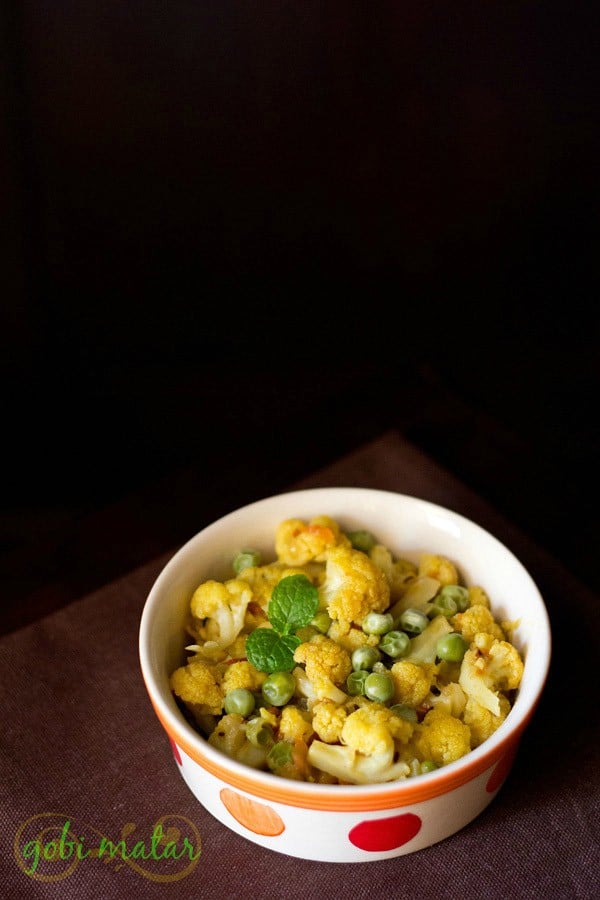
About Gobi Matar
Gobi or cauliflower is a much-loved vegetable in any North Indian, especially Punjabi household. The same is the case with mine as after my marriage, I’m a half Punjabi now. And I totally love it! So, it is also not surprising that we make a Cauliflower dish at least once a week. Typically, I just make Aloo Gobi, Cauliflower Fry, Aloo Gobi Matar or just this Gobi Matar.
Usually, it is a norm that aloo or potatoes have to be added in a dish which has green peas and cauliflower in it. I have the recipe of the aloo gobi matar for the same. Thus, I also restrain myself from adding potatoes when I prepare this specific Gobi Matar recipe. Another similar recipe that you must try is this Bandh Gobi Matar made with cabbage and green peas.
The base of this Gobi Matar is a subtly spiced onion-tomato masala. The heat quotient of the dish is from the green chilies, ginger, red chili powder and garam masala powder. You can increase the quantities of these spice powders and the green chilies to make the dish spicier.
Caraway seeds or shahi jeera is also one of the whole spices that I add in the recipe of this Gobi Matar. This does impart a distinct flavor and aroma to the dish. However, if you don’t have shahi jeera at home, then use cumin seeds or regular jeera.
Also, as I said in the beginning only, if you use the fresh tender seasonal green peas and cauliflower during winters, then the flavors are absolutely on another level. But it does taste just as good with frozen matar and the cauliflower that is available during off-season too.
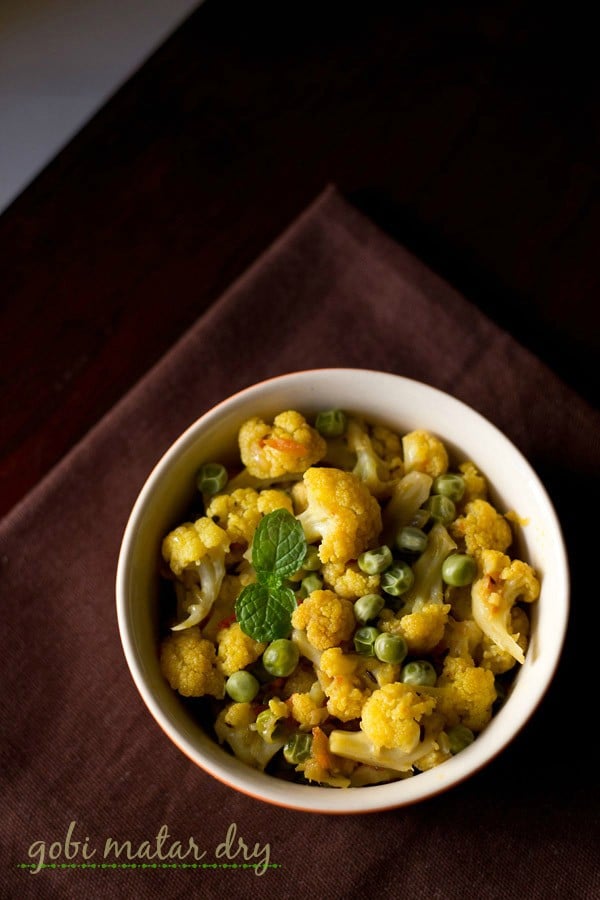
This Gobi Matar is again a family recipe. It is different in the sense that whole spices a.k.a akkha garam masala are sautéed. Generally, whole spices are not added to vegetable dishes. They are added in powdered form as garam masala powder or sabzi masala.
It’s this sautéing of these whole spices with onions and tomatoes that adds to the overall distinctiveness of this Gobi Matar.
Since I did not get tender peas to prepare this dish, I cooked the green peas first as otherwise they take a lot of time to cook. However, the peas were fresh, which were shelled and frozen. If you have green peas that cook faster, then just add them to the dish directly and no need to pre-cook them.
You can easily pair this dry Gobi Matar with your homely chapattis, phulkas and even bread or as a side dish with dal-rice. Alongwith chapattis, it also is a great choice as a tiffin box lunch.
How to make Gobi Matar
Preparation
1. This first step is optional and only if you get cauliflower which has insects. In India, we get insects in cauliflowers and to get rid of them I follow this method.
If you live outside India and get clean cauliflower, then there is no need to follow this method. Just add the cauliflower directly.
Chop or break 1 medium (450 to 500 grams) cauliflower (gobi) into small florets. Rinse and then blanch in hot salted water for 15 to 20 minutes. Drain and keep aside.
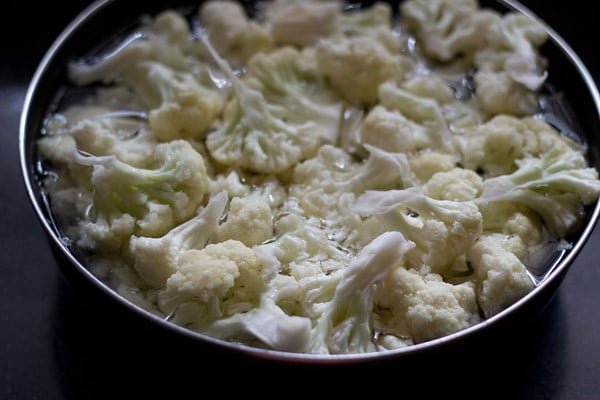
2. Cook ¾ to 1 cup green peas in water till they are almost done. Drain and keep aside.
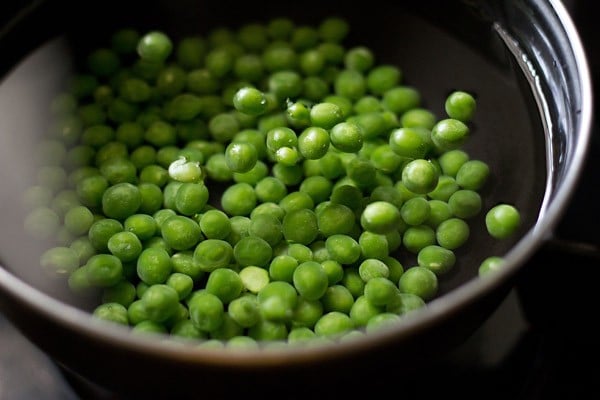
Making onion-tomato masala
3. Heat 2 to 3 tablespoons oil in a kadai or frying pan. Then, crackle the following whole spices – 1 inch cinnamon, 2 to 3 cloves, ½ teaspoon caraway seeds (shahi jeera), ½ of a star anise (chakra phool/optional), 4 to 5 black peppercorns and 1 small to medium bay leaf (tej patta).
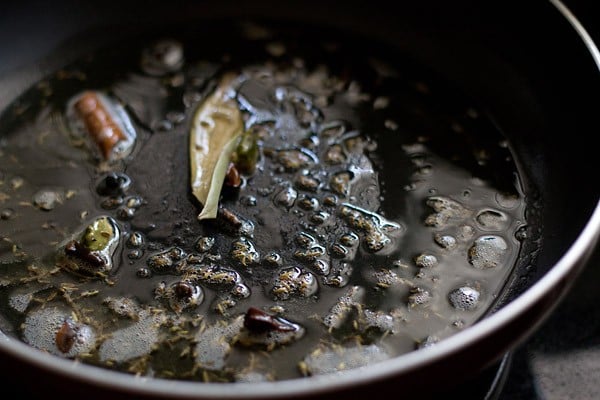
4. Then, add 2 medium finely chopped onions, 2 to 3 finely chopped green chilies, 1 inch finely chopped ginger and 1 to 1.25 teaspoon finely chopped or minced garlic. Sauté the onions till light brown. Stir often.
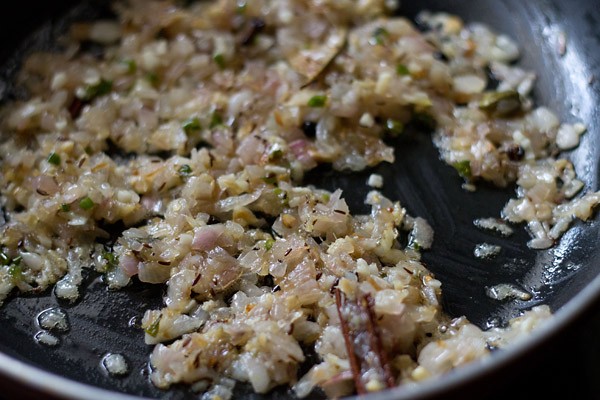
5. Next, add 3 small finely chopped tomatoes and mix well.
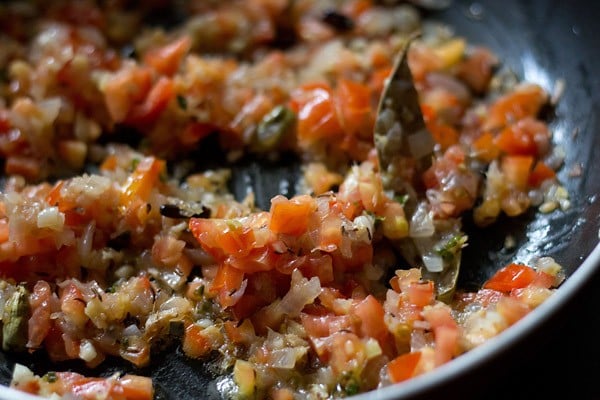
6. Then, add the following spices – ¼ teaspoon turmeric powder, ¼ teaspoon red chili powder (optional) and 1 teaspoon coriander powder. Stir and sauté till the tomatoes soften and you see oil releasing from the sides.
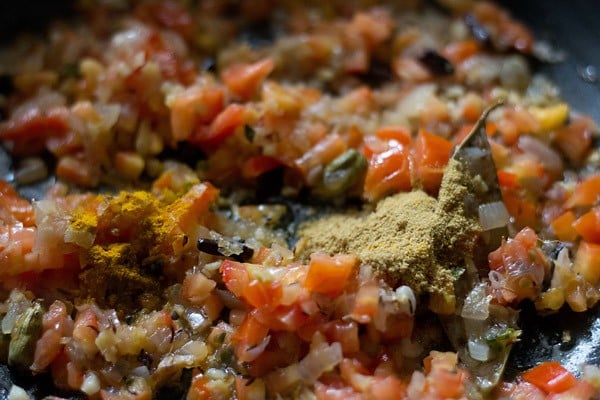
Making Gobi Matar
7. Add the blanched cauliflower florets.
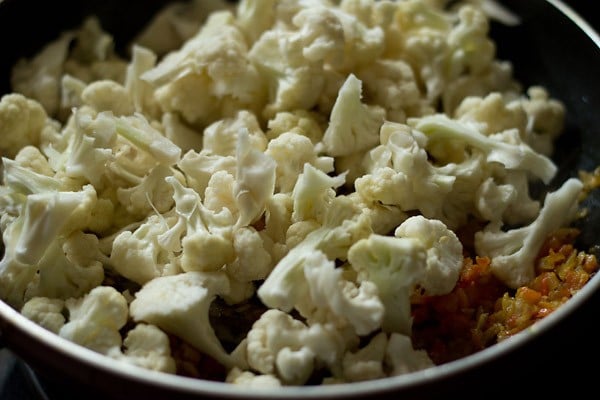
8. Stir well so that the onion-tomato mixture mixes uniformly with the cauliflower florets.
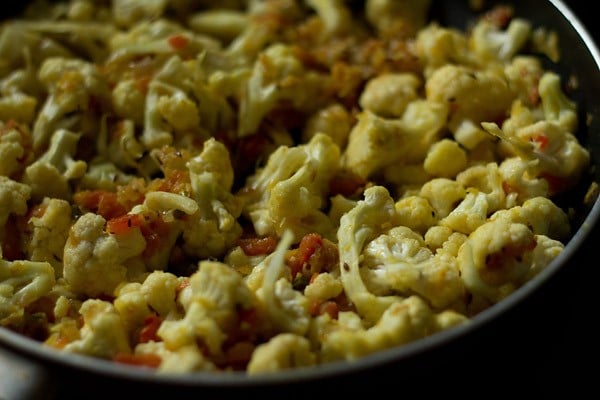
9. Cover with a rimmed lid or plate in which water is added. Cooking with this technique does not burn the cauliflower. Also, you don’t need to add any water in the cauliflower. A lot of steam is formed inside the pan which helps in cooking the cauliflower.
Check the vegetable after some minutes and stir. If the water dries up in the lid/plate, then add more water.
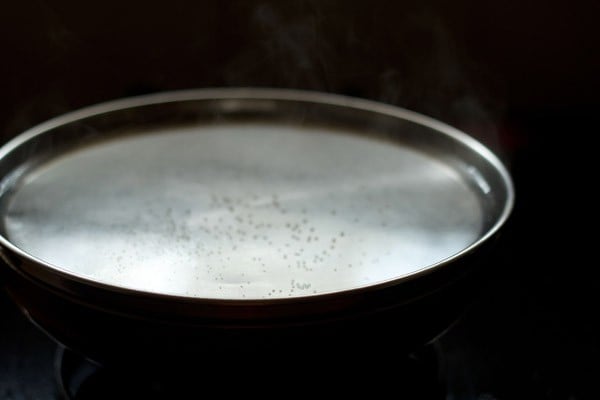
10. When the cauliflower is almost cooked, add the cooked green peas and ¼ teaspoon garam masala powder.
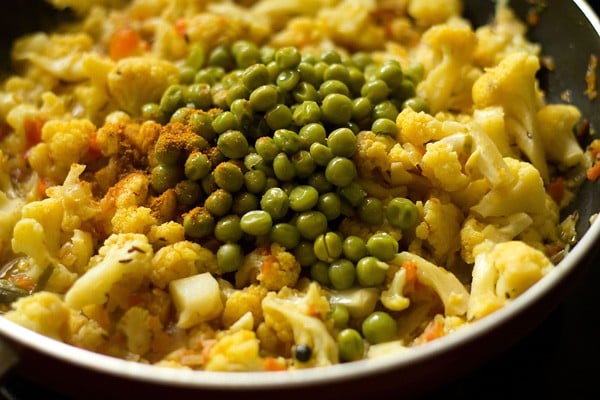
11. Stir and cover with the rimmed lid with water in it. Cook for another 7 to 10 minutes on low heat or till the cauliflower and peas have become tender and cooked well. Once done, if there is any moisture in the pan, cook without the lid and let the moisture dry up.
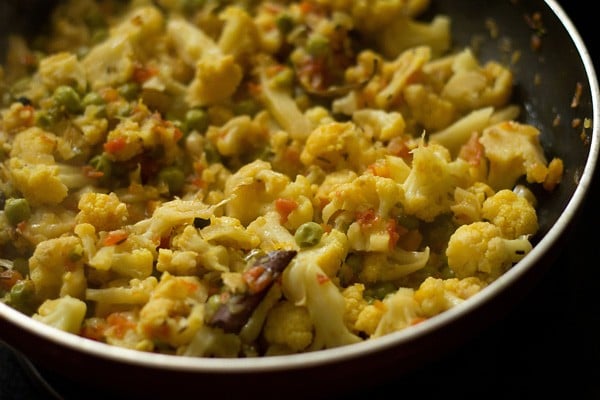
12. Garnish with mint leaves or chopped coriander leaves. Serve Gobi Matar hot or warm with chapattis, rotis, jeera paratha or plain paratha.
You can also pack it in tiffin box or serve as a side dish with dal-rice, rasam-rice or with any Indian meal. You can also use it as a stuffing for making sandwiches. Sometimes we have it with bread slices.
For more delicious matar recipes, you can check this collection of Matar Recipes.
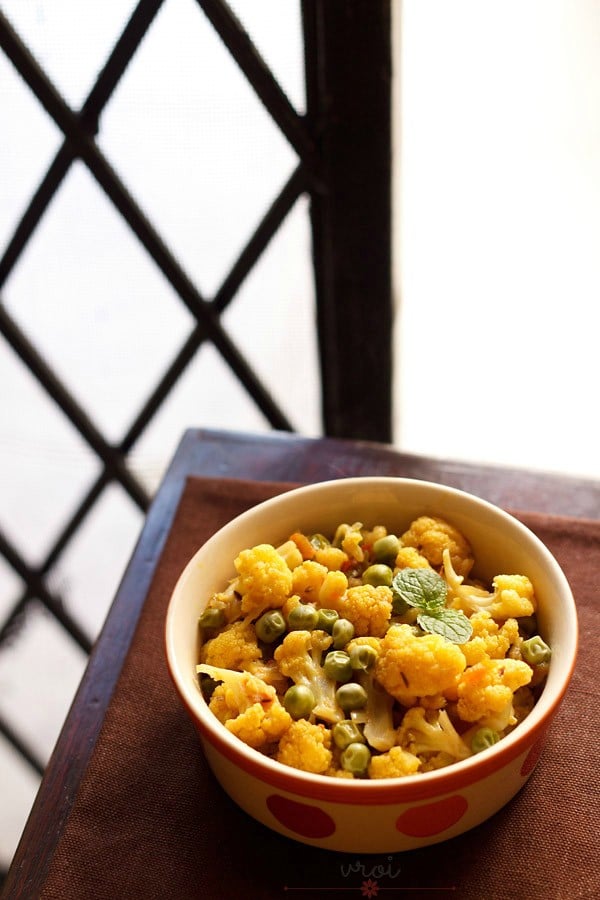
Expert Tips
- If adding tender or frozen peas which cook faster, then add them when you add the cauliflower florets.
- If you live in a place where you get clean cauliflower without any insects or worms, then skip the first step. If not, then you will have to blanch the florets in hot salted water for about 15 to 20 minutes to get rid of the worms and insects.
- Decrease or increase the quantity of green chilies and the spice powders to adjust the level of heat in the dish, as per your liking.
- While cooking the cauliflower, you don’t have to add any water to it as a lot of steam is formed inside the pan. This helps to cook the vegetable.
- Once the Gobi Matar is cooked, check. If the pan still has any moisture in it, then cook without the lid till the moisture dries up.
More Tasty Recipes To Try!
Vegetable Recipes
Okra Recipes
Curry Recipes
Vegetable Recipes
Please be sure to rate the recipe in the recipe card or leave a comment below if you have made it. For more vegetarian inspirations, Sign Up for my emails or follow me on Instagram, Youtube, Facebook, Pinterest or Twitter.
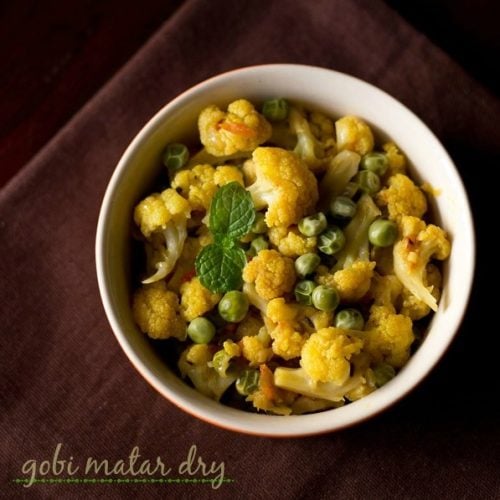
Gobi Matar | Gobhi Matar ki Sabji
Ingredients
- 450 to 500 grams cauliflower or 1 medium cauliflower
- ¾ to 1 cup peas – fresh or frozen (check notes on when to add tender or frozen peas)
- 120 grams onion or 2 medium sized onions – about 1 cup finely chopped onions
- 1 large tomato or 3 small sized tomatoes – about ¾ cup finely chopped tomatoes
- 2 to 3 green chillies or ½ to ¾ teaspoon finely chopped green chilies – reduce the amount of green chilies if making for kids
- 1 inch ginger – about 1 to 1.25 teaspoon finely chopped or minced/grated ginger
- 6 to 7 medium sized garlic or 4 to 5 large garlic – about 1 to 1.25 teaspoon finely chopped or minced garlic
- ½ teaspoon caraway seeds (shah jeera)
- 1 inch cinnamon
- 2 green cardamoms
- ½ of a star anise (chakra phool) – optional
- 4 to 5 black pepper
- 1 small to medium tej patta (indian bay leaf)
- ¼ teaspoon turmeric powder
- ¼ teaspoon kashmiri red chili powder (optional)
- 1 teaspoon Coriander Powder
- ¼ teaspoon Garam Masala
- 2 to 3 cloves
- 2 to 3 tablespoon oil
- salt as required
- some chopped mint leaves or coriander leaves for garnish
Instructions
preparation
- Chop or break the cauliflower/gobi into small florets.
- This step is optional and only if you get cauliflower which has insects. In india we get insects in cauliflowers and to get rid of them I follow this method. If you live outside india and get clean cauliflower then there is no need to follow this method. Just add the cauliflower directly.
- Rinse them and then blanch in hot salted water for 15 to 20 mins. Drain and keep aside.
- First cook the peas in water till they are almost cooked. Then drain and keep aside.
making gobi matar
- Heat oil in a kadai or a frying pan and crackle the whole spices viz – cinnamon, cloves, caraway seeds, star anise, black pepper and indian bay leaf (tejpatta).
- Add the finely chopped onions, green chilies, ginger and garlic. Stirring often saute the onions till they become light brown.
- Then add the finely chopped tomatoes.
- Then add turmeric powder, red chili powder and coriander powder. Stir and saute till the tomatoes soften and you see the oil releasing from the sides.
- Add the blanched gobi/cauliflower florets.
- Stir well so that the onion tomato and spices mix uniformly with the cauliflower florets.
- Cover with a rimmed lid in which water is added. Cooking with this technique does not burn the cauliflower.
- Also you don’t need to add any water in the cauliflower. A lot of steam is formed inside the pan which helps in cooking the cauliflower.
- Do check the veggie after a some minutes and stir. If the water dries up in the lid, then add more water.
- When the gobhi is almost cooked, add the peas/matar and garam masala powder.
- Stir and cover with the rimmed lid with water in it. Cook for a further 7 to 10 minutes on a low flame, till the cauliflower and peas have become tender and cooked well. Once done, if there is any moisture in the pan, then cook without the lid and let the moisture evaporate.
- Garnish with chopped mint leaves or coriander leaves. Serve gobi matar hot or warm with chapatis or phulkas or plain paratha or jeera paratha or bread.
- This gobhi matar ki sabji can also be packed in tiffin box or serve as a side dish with dal rice or rasam rice or with any Indian meal.
Notes
- If adding tender or frozen peas which cook faster, then add them when you add the cauliflower florets.
- The amount of spices can be altered as per your taste preferences.
Nutrition Info (Approximate Values)
This Gobi Matar recipe from the archives was first published in February 2014. It has been updated and republished in April 2024.
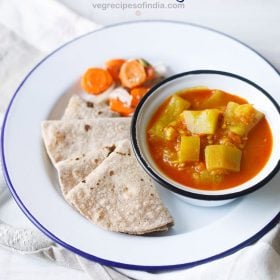
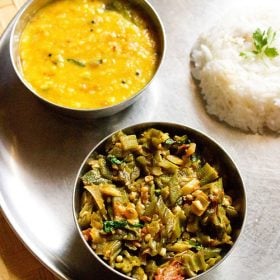
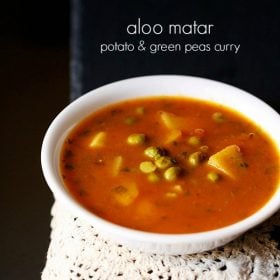
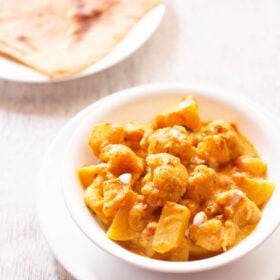








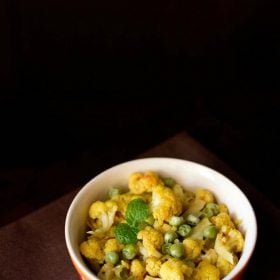
Excellent article. Simple , clear and does the job.
Thanks Ankit
Hi dasana..ur recipez r 2 good..i love it..can i prerpare diz recipe without garlic..using the same method..
yes tanusha you can make this gobi matar without garlic too, thanks.
Thank u soo much .aap ki recipes dekhar khana banana mere liye bhaut esy hogya .bhaut hi delicious .thanks
welcome deepa 🙂 thanks for positive views glad you found our recipes easy.
Very good, as all the recipes I tried. Thank you.
welcome sari
Dassana,
All of your recipes that I’ve tried are very good, and so well presented. You make it easy to follow. I have learned a lot from you and visit your site often, giving you lots of clicks!
I never make “comments” on line…but your website is head and shoulders above most of what is out there.
Thank you for being excellent.
Peace,
Crislyn
welcome crislyn. glad to know this. thanks for sharing positive feedback. peace and love.
Hello Dassana,
Thank you for excellent recipes!
I’m curious on how water placed in the rimmed plate can create steam in the pot.
Thanks again,
Harshad
Welcome Harshad. This particular technique is used in many households. The water which is on the lid helps in condensation of the steam escaping from the vegetables and this collects on the inside of the lid and then falls back into the pan. Thus creating a cycle and cooking the vegetable in its own moisture or water content. I hope this helps.